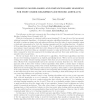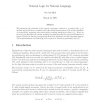5122 search results - page 54 / 1025 » Comparing Consequence Relations |
ICML
2005
IEEE
14 years 9 months ago
2005
IEEE
T ORDER REGRESSION (EXTENDED ABSTRACT) Kurt Driessensa Saso Dzeroskib a Department of Computer Science, University of Waikato, Hamilton, New Zealand (kurtd@waikato.ac.nz) b Departm...
TBILLC
2005
Springer
14 years 2 months ago
2005
Springer
We implement the extension of the logical consequence relation to a partial order ≤ on arbitary types built from e (entities) and t (Booleans) that was given in [1], and the de�...
SIGIR
2006
ACM
14 years 3 months ago
2006
ACM
This paper studies the problem of identifying comparative sentences in text documents. The problem is related to but quite different from sentiment/opinion sentence identification...
BPM
2006
Springer
14 years 22 days ago
2006
Springer
In various application domains there is a desire to compare process models, e.g., to relate an organization-specific process model to a reference model, to find a web service match...
JSYML
2007
13 years 9 months ago
2007
We examine several conditions, either the existence of a rank or a particular property of þ-forking that suggest the existence of a well-behaved independence relation, and determi...


